You should upgrade or use an alternative browser.
Phenylacetone Synthesis Methods, Properties, Uses
Phenylacetone Synthesis Methods, Properties, Uses
Introduction
Phenylacetone (P2P) is a chemical compound with a distinct aroma that has been used in various industries, including pharmaceuticals, perfumery, and the production of illegal drugs. Its synthesis, sale, and use have been regulated due to its potential for abuse and the associated risks to public health. This article will provide an overview of Phenylacetone (P2P), its properties, synthesis, uses, legal status, and history.
Phenylacetone (P2P) Formula
What is Phenylacetone (P2P)?
Phenylacetone (P2P) is an organic compound with the chemical formula C6H5CH2C(O)CH3. It is also known as benzyl methyl ketone, 1-phenyl-2-propanone, or methyl benzyl ketone (BMK). Phenylacetone (P2P) is a colorless to pale-yellow liquid with a distinct, floral-like odor. It is an organic compound with the chemical formula C8H8O, and it has a molecular weight of 134.21 g/mol. P2P is classified as an aromatic ketone due to the presence of an aromatic benzene ring and a ketone functional group in its chemical structure.
Phenylacetone (P2P) Appearance
In terms of its physical properties, P2P is insoluble in water, but it is highly soluble in many organic solvents, such as ethanol, ether, and chloroform. Its boiling point is approximately 215-216 °C, and its melting point is around -15 °C, density is 1.0057 g/cm3; Phenylacetone (P2P) is a reactive chemical compound that can undergo various chemical reactions. For example, it can be oxidized to form phenylacetic acid, can be reduced to form secondary alcohols, such as phenyl-2-propanol.
P2P is also known for its distinctive odor, which has been described as sweet, floral, and fruity. This aroma makes it a popular ingredient in the perfume and fragrance industry. However, the strong odor of P2P can also make it difficult to handle in large quantities, and it can be irritating to the respiratory system if inhaled. In terms of its chemical reactivity, P2P is susceptible to nucleophilic addition reactions due to the presence of the ketone functional group. It can also undergo reduction reactions to form secondary alcohols, such as phenyl-2-propanol. Additionally, P2P can be used as a precursor for the synthesis of many other chemical compounds, including pharmaceuticals and agrochemicals.
Synthesis of Phenylacetone (P2P)
An amazing variety of artificial pathways to this substance exist, both because of the relatively uncomplicated construction of the substance, and also because of its widespread use. Many of the earliest pathways to the substance have been more or less disregarded due to prohibitions on the pre-precursors employed to create it, but new techniques of manufacturing the compound have constantly emerged. Here is a roster of the most prevalent procedures for synthesizing phenyl-2-propanone.
Synthesis of P2P from P2NP with NaBH4 and K2CO3/H2O2
Phenyl-2-Propanones from Acetone Mn(III)-Catalyzed Aromatic Acetonylation
1-Phenyl-2-propanone (P2P) from Diethyl(phenylacetyl)malonate
Synthesis of P2P from Benzaldehyde with MEK
Synthesis of P2P by oxidation of alpha-methylstyrene with Oxone (Potassium Peroxomonosulfate)
Phenylacetone (P2P) syntheses via Grignard reagents
Phenylacetone from BMK methyl glycidate
However, due to its potential for abuse, the synthesis, sale, and use of Phenylacetone (P2P) are heavily regulated in most countries. This is because P2P can be used as a precursor for the illegal production of amphetamine and methamphetamine.
Phenyl-2-propanone from acetone and benzene
Phenylacetone Purification
Phenylacetone (P2P) is a key-reagent for a methamphetamine synthesis and can be used for an amphetamine synthesis as well. Our experiments have clearly showed that P2P purity have direct impact on the methamphetamine synthesis yield and its purity [via sodium borohydride (NaBH4) methylamination reduction method]. The purer P2P is used, the higher yield is obtained. To top it off, BB Forum research team decided that it is strategically important to represent such substantial purification way as a P2P steam distillation.
Uses of Phenylacetone (P2P)
Phenylacetone (P2P) has a wide range of uses in various industries due to its unique chemical properties. One of its main applications is in the fragrance and perfume industry. The floral-like odor of P2P makes it a popular ingredient in many fragrances and perfumes, particularly those with a fruity or floral scent.
P2P is also used in the synthesis of various chemical compounds, including pharmaceuticals and agrochemicals. It is a precursor for the synthesis of ephedrine and pseudoephedrine, which are used as decongestants in many over-the-counter cold and flu medications. Additionally, P2P can be used in the synthesis of amphetamine and methamphetamine, although its use in the illegal production of these drugs is heavily regulated or banned in most countries due to their potential for abuse.
Phenylacetone Barrel (P2P) From Breaking Bad Series
Another important use of P2P is in the manufacture of resins and adhesives. Its unique chemical structure makes it a useful building block for the synthesis of these materials, which have many applications in construction, automotive, and packaging industries.
Legal Status of Phenylacetone (P2P)
The sale and use of Phenylacetone (P2P) are heavily regulated in most countries due to its potential for abuse and the associated risks to public health. In the United States, P2P is listed as a controlled substance under Schedule II of the Controlled Substances Act, meaning it has a high potential for abuse and dependence.
In other countries, such as Australia, Canada, and the United Kingdom, P2P is also regulated as a controlled substance. Because of its usefulness as a precursor in the fabrication of Methamphetamine, phenylacetone is included in Class I of the regulated chemicals under the Basic Substances Monitoring Act in the EU. As a consequence, its production, commerce, importation and exportation without authorization are illegal and subject to penalty.
Toxicity and Rules for Phenylacetone Handling
Phenylacetone (P2P) is a reactive and potentially hazardous chemical compound that requires careful handling and storage to prevent exposure to individuals and the environment. It can be toxic if inhaled, ingested, or absorbed through the skin. The following are some of the rules for handling P2P to ensure safe use and storage:
- Personal protective equipment (PPE) should be worn at all times when handling P2P. This includes gloves, goggles, and a lab coat.
- P2P should be stored in a cool, dry, well-ventilated area away from sources of heat and light.
- P2P should be stored in airtight containers to prevent leaks or spills.
- P2P should be handled in a fume hood to prevent exposure to fumes and vapors.
- Avoid inhaling or ingesting P2P. If it comes in contact with skin, wash the affected area immediately with soap and water.
- Avoid mixing P2P with other chemicals or substances, as it may react and produce toxic byproducts.
- Dispose of P2P and all contaminated materials according to local, state, and federal regulations.
In addition to these handling rules, it is important to be aware of the potential health effects associated with exposure to P2P. Inhalation of P2P can cause irritation of the respiratory system, while ingestion can cause nausea, vomiting, and abdominal pain. Long-term exposure to P2P may result in damage to the liver, kidneys, and nervous system.
Conclusion
Phenylacetone (P2P) is a versatile chemical compound with various applications in the pharmaceutical, perfumery, and flavor industries. However, due to its potential for abuse and its use in the illegal production of amphetamine and methamphetamine, the sale and use of P2P are heavily regulated in most countries. Despite its regulatory status, P2P continues to be used as a precursor for the production of illegal drugs. This has led to a significant public health concern, as the use of amphetamine and methamphetamine can cause severe health problems, including addiction, psychosis, and overdose. Therefore, it is essential to recognize the potential risks associated with the production, sale, and use of Phenylacetone (P2P) and to adhere to the regulations put in place to control its use. By doing so, we can help to prevent the abuse of P2P and the associated risks to public health. As such, it is crucial to be aware of these regulations and the potential risks associated with P2P and to adhere to them to promote public safety and well-being.
-

Phenyl-2-Propanone from Phenylpropanolamine, Cathine, Ephedrine, and Pseudoephedrine.
Phenyl-2-Propanone can be made by boiling Ephedrine, Pseudoephedrine, Cathine, or Phenylpropanolamine with Sulfuric Acid and Zinc Chloride. https://erowid.org/archive/rhodium/chemistry/p2p.ephedrine.html- BlueDex
- Thread
- 1-phenyl-2-propanone cathine ephedrine phenyl-2-propanone phenylpropanolamine proin pseudoephedrine
- Replies: 1
- Forum: Precursors
-

Get Diethyl(phenylacetyl)malonate on BB Forum
Where I can find Diethyl(phenylacetyl)malonate? Diethyl(phenylacetyl)malonate CAS 20320-59-6 is in demand in amphetamine and methamphetamine synthesis industry by reason that it's alternative source of phenylacetone (P2P). This direct P2P (main methamphetamine precursor) precursor is legal and...- G.Patton
- Thread
- 1-phenyl-2-propanone bmk cas 103-79-7 cas 20320-59-6 diethyl(phenylacetyl)malonate diethyl(phenylacetyl)malonate synthesis phenylacetone (p2p)
- Replies: 6
- Forum: Information from the Administration
-
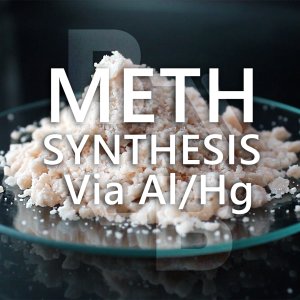
Methamphetamine Synthesis From P2P Via Al/Hg
https://bbgate.com/threads/methamphetamine-synthesis-from-p2p-via-al-hg.8568/ 1) Production of Aluminum Amalgam 2) Reductive Amination and Extraction 3) Methamphetamine Free Base Isolation and Hydrochloride Salt Crystallization- Novator
- Media item
- 1-phenyl-2-propanone amphetamine cas 103-79-7 crystallization meth meth synthesis methamphetamine hydrochloride methamphetamine synthesis p2p phenylacetone stimulant synthesis
- Comments: 140
- Category: Synthesis of Amphetamines (Phenylethylamines)
-

Steam P2P Distillation as a Purification Method
Introduction Phenylacetone (P2P) is a key-reagent for a methamphetamine synthesis and can be used for an amphetamine manufacturing as well. Our experiments have clearly showed that P2P purity have direct impact on the methamphetamine synthesis yield and its purity [via sodium borohydride (NaBH4)...- G.Patton
- Thread
- 1-phenyl-2-propanone bmk bmk cleaning method cas 103-79-7 p2p p2p purification phenylacetone steam distillation
- Replies: 13
- Forum: Precursors
-
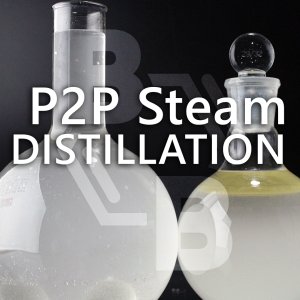
Steam P2P Distillation as a Purification Method
Steam P2P Distillation as a Purification Method https://bbgate.com/threads/steam-p2p-distillation-as-a-purification-method.8322/- G.Patton
- Media item
- 1-phenyl-2-propanone bmk cleaning method cas 103-79-7 p2p p2p purification phenylacetone steam distillation
- Comments: 30
- Category: Synthesis of Amphetamines (Phenylethylamines)
-
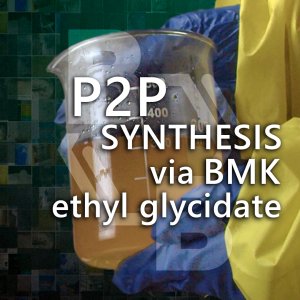
Phenylacetone (P2P) Synthesis Via BMK Ethyl Glycidate
1) BMK ethyl glycidate synthesis from benzaldehyde. 2) BMK glycidic acid (sodium salt) synthesis BMK ethyl glycidate. 3) Phenylacetone (P2P) synthesis from BMK glycidic acid (sodium salt). https://bbgate.com/threads/phenylacetone-p2p-synthesis-via-bmk-ethyl-glycidate.7549/- Novator
- Media item
- 1-phenyl-2-propanone benzaldehyde bmk bmk ethyl glycidate bmk glycidic bmk synthesis meth p2p p2p synthesis synthesis
- Comments: 65
- Category: Synthesis of Amphetamines (Phenylethylamines)
-
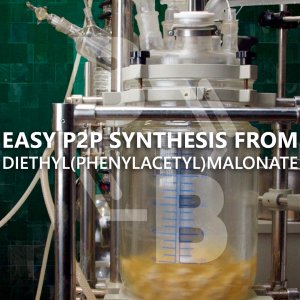
Easy P2P synthesis from Diethyl(phenylacetyl)malonate
Diethyl(phenylacetyl)malonate Hydrolysis to BMK and PAA (phenylacetone and phenylacetic acid). https://bbgate.com/threads/1-phenyl-2-propanone-p2p-synthesis-from-diethyl-phenylacetyl-malonate.1646/- Novator
- Media item
- 1-phenyl-2-propanone bmk diethyl(phenylacetyl)malonate hydrolysis methamphetamine p2p paa phenylacetic acid phenylacetone
- Comments: 19
- Category: Synthesis of Amphetamines (Phenylethylamines)
-
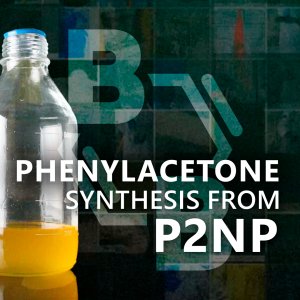
Phenylacetone (P2P) synthesis
Phenylacetone (P2P) synthesis from P2NP. https://bbgate.com/threads/p2p-synthesis-from-p2np.188/- Novator
- Media item
- 1-phenyl-2-propanone amphetamine methamphetamine p2np p2p p2p/bmk oil synthesis phenyl-2-nitropropene phenylacetone stimulant video synthesis
- Comments: 52
- Category: Synthesis of Amphetamines (Phenylethylamines)
-
R
Synthesis of 1-phenyl-2-propanone (P2P) using aniline
This article provides you with a low-cost, mild condition, high-yield P2P synthesis process, and the conditions are easy to scale.It's just that I don't know if the raw material aniline is regulated in other countries, but it is quite cheap in my country, only about 1 US dollar per kilogram. The...- Re186
- Thread
- 1-phenyl-2-propanone aniline diazonium salt high yield low cost p2p
- Replies: 13
- Forum: Precursors
-

1-Phenyl-2-propanone (P2P) synthesis from Diethyl(phenylacetyl)malonate
Introduction This is one of the simplest ways to obtain 1-Phenyl-2-propanone (P2P). Diethyl(phenylacetyl)malonate can be bought in some web market quite easy or synthesized by yourself using this method. Also, you can learn other P2P synthetic paths in our forum by following links: Synthesis of...- G.Patton
- Thread
- 1-phenyl-2-propanone bmk cas 20320-59-6 diethyl(phenylacetyl)malonate p2p phenylacetylmalonate
- Replies: 159
- Forum: Precursors
-

P2P Synthesis From P2NP
Reagents: 1-Phenyl-2-nitropropene (P2NP; cas 705-60-2) 1000 g; Methanol (MeOH) 10 L; Sodium borohydride (NaBH4) 470 g; Hydrogen peroxide (H2O2) 30% 6 L; Potassium carbonate (K2CO3) 1800 g; Hydrochloric acid (HCl) 37% aq; Dichloromethane (CH2CI2) 5 L; Sodium hydroxide (NaOH) 5 L 25% aq...- GhostChemist
- Thread
- 1-phenyl-2-nitropropene 1-phenyl-2-propanone bmk cas 103-79-7 cas 705-60-2 p2np p2p p2p synthesis p2p synthesis from p2np phenylacetone synthesis
- Replies: 68
- Forum: Precursors
-

Phenylacetone (P2P) synthesis from benzaldehyde with butanone
Reagents: Benzaldehyde 1000 g; Methyl ethyl ketone (MEK) 1000 ml; Distilled water 14.5 L; Chloroform (CHCl3) 7.6 L; Sodium bicarbonate solution (NaHCO3); Magnesium sulphate (Na2SO4) anhydrous; Glacial acetic acid 10 L; Hydrogen peroxide (H2O2) 1300 g 50 %; Sodium hydroxide (NaOH) 600 g...- William D.
- Thread
- 1-phenyl-2-propanone benzaldehyde bmk cas 20320-59-6 methyl ethyl ketone p2p phenylacetone
- Replies: 495
- Forum: Precursors
-

1-Phenyl-2-propanone (P2P) Leuckart amination to amphetamine and methamphetamine. Smale scale.
Amphetamine Reagents: 1-Phenyl-2-propanone (P2P) 0.827 g, 6.2 mmol; Formamide 3.5 ml; Benzene 50 ml; Magnesium sulphate (MgSO4); Methanol 5 ml (MeOH); Hydrochloric acid (15 % aq HCl) 5 ml; Distilled water 25 ml; Dichloromethane (DCM) 90 ml; Sodium hydroxide (NaOH) pellets; Sulfuric acid...- William D.
- Thread
- 1-phenyl-2-propanone adderall amphetamine cas 103-79-7 ice leuckart leuckart amination meth methamphetamine p2p
- Replies: 131
- Forum: Amphetamine
About Us
Our team brings together the best specialists from different fields.
We are ready to share our experience, discuss difficult issues and find new solutions.
